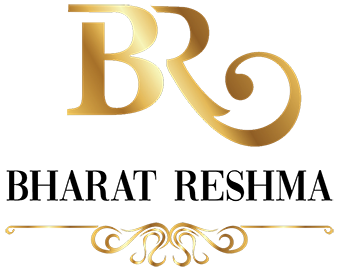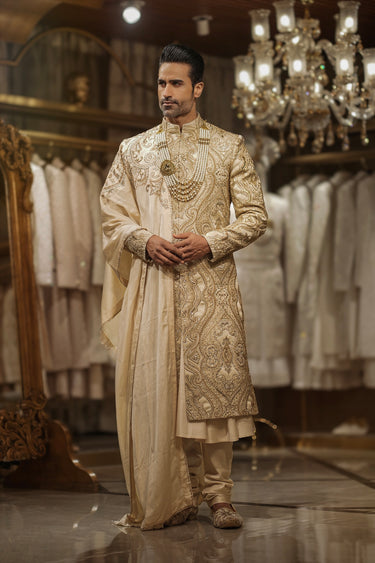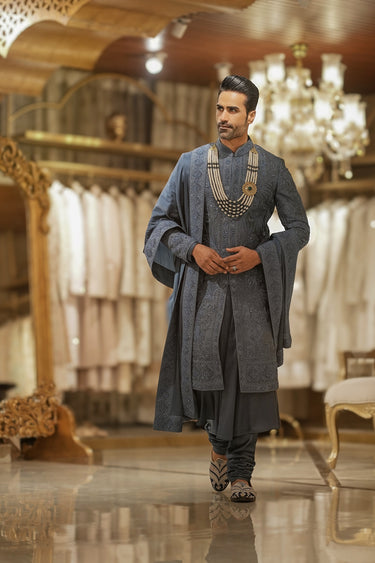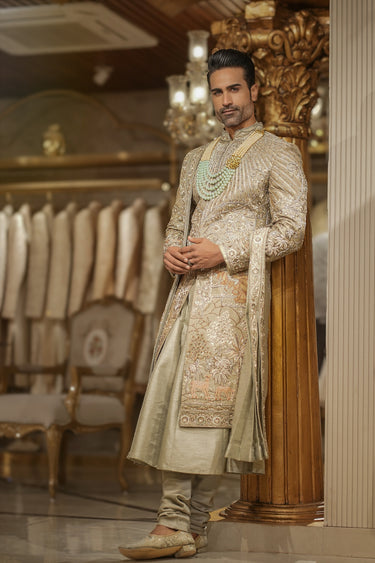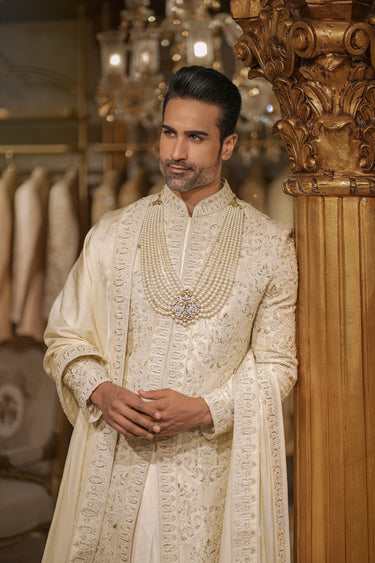Royal Weddings to Festivals: The Versatile Sherwani

Table of Contents
Sherwanis are one of the most versatile traditional Indian garments. They are not only steeped in rich cultural heritage, but they are also the perfect choice for a wide range of occasions. From royal weddings to festivals, sherwanis are an integral part of Indian culture and fashion. Sherwanis have been around for centuries and are believed to have originated in the royal courts of northern India. The garment was favored by kings and nobles as a symbol of wealth, status, and elegance. Over time, sherwanis have evolved and adapted to suit the changing fashion trends and modern lifestyle. Today, they are a popular choice for grooms, groomsmen, and other men who want to make a statement on special occasions.
One of the most significant events in which sherwanis are a must-have attire is weddings. They are the perfect outfit for grooms and add an extra touch of elegance to the wedding ceremony. Sherwanis come in a wide range of styles, designs, and colors, making it easy for grooms to find the perfect one to match their personal style and taste. From traditional, embellished sherwanis to modern, minimalistic designs, there is a sherwani to suit every groom's style.
The design of the sherwani is another important consideration. From traditional, embroidered designs to modern, minimalist styles, the design of the sherwani can have a big impact on the overall look of the outfit. It is important to choose a design that matches your personal style and the occasion. For example, a traditional, embellished sherwani may be perfect for a wedding, while a modern, minimalistic design may be a better choice for a formal business event.
Finally, the color of the sherwani is another important factor. Traditionally, sherwanis are available in rich, deep colors such as red, green, and blue. However, modern sherwanis are available in a wide range of colors, including pastels, neutrals, and even bold, bright hues. The color of the sherwani should complement your skin tone and the occasion. For example, a light-colored sherwani may be perfect for a summer wedding, while a darker color may be a better choice for a formal event.
In conclusion, sherwanis are a versatile and timeless garment that have been a part of Indian culture and fashion for centuries. Whether it is for a wedding, festival, or formal event, a sherwani is a perfect way to show your respect.
The History and Legacy of the Sherwani
» The Mughal Origins of the Sherwani
The sherwani is a traditional form of men's clothing originating from the Indian subcontinent. It is typically worn over a kurta, a long shirt or tunic, and paijama trousers. The sherwani is usually made from heavy fabrics such as wool or brocade and is often embellished with embroidery or other ornamentation.
The sherwani originated during the rule of the Mughal Empire in the 16th century. At that time, it was known as a choga and was worn by members of the imperial court. The choga was a loose-fitting garment with wide sleeves and an ankle-length hem. It was often made from richly decorated fabrics such as brocade or velveteen and was often worn over another garment such as a qamis (a type of tunic).
During the reign of Shah Jahan, the fifth Mughal emperor, the choga evolved into the more fitted and decorated garment that we now know as the sherwani. Shah Jahan was known for his love of luxury and his patronage of the arts, both of which are reflected in the sherwani. The new style became increasingly popular among nobility and royals during Shah Jahan's reign and continued to be worn during subsequent dynasties.
» The Revival of the Sherwani in the 19th Century
The sherwani fell out of fashion after the collapse of the Mughal Empire in 1857 but experienced a revival in popularity during British colonial rule in India in the late 19th century. At that time, it became fashionable for British aristocrats and Indian royals to wear Western-style clothing such as morning coats and tailcoats for formal occasions. However, they also began to adopt elements of Indian dress for informal occasions such as attending garden parties or going on safari hunts.
One early adopter of this trend was Lord Curzon, who served as Viceroy of India from 1899 to 1905. Lord Curzon was an ardent admirer of Indian culture and an enthusiastic collector of Indian artifacts; he even helped found the National Museum in New Delhi. He frequently wore Indian dress on informal occasions, including sherwanis on several occasions. His example helped popularize Indian dress among British aristocracy and Indian royalty alike.
» The Sherwani's Place in Modern-Day Culture
Today, sherwanis are most associated with weddings but can be worn on many different types of occasions. They are popular not only among Indians but also among Pakistani grooms (who typically wear them with Western-style suits) and even some British grooms (who may opt for a more traditional morning coat for their wedding day). In recent years, designers have also begun creating more casual versions of the sherwani that can be worn without a kurta underneath; these are perfect for summer events or more relaxed gatherings.
While the sherwani may have originated as a garment for nobility and royalty, it has now become more accessible to people of all backgrounds. Whether you are attending a friend's wedding or celebrating a special occasion, there's a sherwani out there that's perfect for the occasion.
The Types and Styles of Sherwanis
» Traditional Sherwanis -
The traditional sherwani is a long, button-up coat that is worn over a kurta, which is a loose tunic. The sherwani originated in Persia and was introduced to India by the Mughals in the 16th century. Traditional Sherwanis are a type of men's attire commonly worn in South Asian countries, especially during special occasions and formal events such as weddings, festivals, and celebrations. Sherwanis have a long history and are deeply rooted in the cultural heritage of the Indian subcontinent.
Characteristics of Traditional Sherwanis:
Design: Sherwanis typically feature a long tunic-style garment with a straight or flared silhouette. The design often includes intricate embroidery, embellishments, or traditional handwork, which varies depending on the region and occasion.
Fabric: Traditional Sherwanis are made from various fabrics, including silk, brocade, velvet, or other luxurious materials. The choice of fabric depends on personal preferences, climate, and the formality of the event.
Colors: Sherwanis come in a wide range of colors, but popular choices include rich and vibrant hues such as deep red, maroon, royal blue, gold, ivory, and black.
Collar and Buttons: Sherwanis typically have a high collared neckline that adds to the regal look. The front is fastened with buttons or hooks, which can be hidden by a placket for a seamless appearance.
Bottom Wear: Sherwanis are usually paired with churidar pants, which are snug-fitting trousers with gathered fabric at the ankles. The combination of the Sherwani and churidar is a classic traditional ensemble.
Dupatta: Some Sherwanis might be accompanied by a matching or contrasting dupatta, which is a long, flowing scarf often draped over the shoulder or wrapped around the neck.
Embellishments: Traditional Sherwanis are known for their intricate embellishments and designs. These may include zari work (metallic threads), sequins, beads, stones, or intricate embroidery like zardozi, gotta patti, or mirror work.
» Contemporary Sherwanis -
Contemporary sherwanis are more modern interpretations of the traditional garment. They are usually made from lighter fabrics such as cotton or linen and have a simpler design. Contemporary sherwanis can be styled in various ways, from pairing it with jeans to wearing it as a standalone garment. These contemporary designs cater to the evolving tastes and preferences of individuals and are often favored by younger generations.
Key features of Contemporary Sherwanis:
Simplified Silhouettes: While traditional Sherwanis often feature elaborate and voluminous silhouettes, contemporary designs tend to be more streamlined and tailored. They may have slimmer cuts and sleeker profiles, making them more versatile for various occasions.
Modern Fabrics: While traditional Sherwanis predominantly use luxurious fabrics like silk and brocade, contemporary designs might incorporate other modern materials such as linen, cotton, or blends to provide comfort and a lighter feel.
Minimalist Embellishments: Instead of heavy embellishments, contemporary Sherwanis often focus on minimalist designs with subtle embroidery or unique textures. This minimalist approach appeals to those who prefer a more understated and modern aesthetic.
Fusion with Western Elements: In some cases, contemporary Sherwanis blend traditional South Asian elements with Western influences. This fusion might involve incorporating modern lapels, button styles, or jacket lengths, creating a distinct cross-cultural look.
Diverse Color Palette: While traditional Sherwanis traditionally stick to rich and vibrant colors, contemporary designs may explore a wider range of hues, including pastels, earthy tones, and even monochromatic schemes.
Experimentation with Lengths: Contemporary Sherwanis might experiment with varying lengths, such as shorter knee-length styles or longer ankle-length variations, adding a touch of novelty to the traditional garment.
Layering and Mix-and-Match: Some contemporary Sherwanis allow for layering options, enabling wearers to mix and match different pieces like waistcoats or bundies (short jackets) with the main Sherwani for a more dynamic and personalized look.
Innovative Necklines: While traditional Sherwanis usually have high collars, contemporary designs might explore different neckline styles, including mandarin collars, band collars, or V-necks, giving the outfit a modern twist.
» Designer Sherwanis -
Designer sherwanis are luxury garments that are often custom-made for the wearer. They are usually made from high-end materials such as silk or cashmere and feature intricate embroidery or beadwork. Designer sherwanis are typically worn on special occasions such as weddings or festivals. Designer Sherwanis cater to individuals who seek exclusive, one-of-a-kind garments for special events and occasions.
Key features of Designer Sherwanis:
Exclusive Designs: Designer Sherwanis are known for their exclusive and innovative designs. Fashion designers incorporate their creative vision, artistic flair, and signature style into these garments, making them stand out from mass-produced options.
High-Quality Materials: Designer Sherwanis are crafted from the finest and most luxurious materials, such as pure silk, brocade, velvet, or high-quality blends. The emphasis on premium fabrics enhances the overall look and feel of the garment.
Intricate Embroidery and Embellishments: These Sherwanis often feature intricate hand embroidery, beadwork, sequins, zardozi, gotta patti, or other ornate embellishments. The attention to detail and craftsmanship elevate the Sherwani to a work of art.
Customization: Designer Sherwanis offer the opportunity for customization to suit the individual's preferences and requirements. Customers can work closely with the designer to choose the fabric, colors, embroidery patterns, and other design elements.
Unique Color Combinations: Designers often experiment with unique and unconventional color combinations, giving their Sherwanis a distinct and refreshing look.
Contemporary Elements: Designer Sherwanis may incorporate contemporary design elements and trends while staying true to the traditional roots of the garment. These modern touches can add a contemporary edge to the classic silhouette.
Limited Editions: Some designer Sherwanis are released as limited editions, ensuring exclusivity and rarity. This appeals to individuals who desire a truly exceptional and exceptional piece.
Celebrity Endorsements: Designer Sherwanis are sometimes worn by celebrities and prominent figures, contributing to their popularity and prestige.
Expensive Price Range: Due to their bespoke nature, exquisite craftsmanship, and use of premium materials, designer Sherwanis tend to be relatively expensive compared to off-the-rack options.
Popular Occasions for Wearing a Sherwani
» Royal Weddings
One of the most popular occasions for wearing a sherwani is at a royal wedding. Sherwanis are often seen as the height of elegance and sophistication, making them the perfect choice for a formal occasion like a royal wedding.
In 2018, when Prince Harry married Meghan Markle, many of the guests wore sherwanis as part of their wedding attire. Some of the most notable guests who opted for a sherwani include Idris Elba, David Beckham, and Serena Williams.
While you might not have the opportunity to attend a royal wedding anytime soon, you can still rock a sherwani at your own formal events like weddings or black-tie parties.
» Festivals and Celebrations
Sherwanis are also popular during festivals and celebrations in India and Pakistan. They are often worn during Diwali, Eid, and other religious holidays. Sherwanis are also commonly seen at Indian weddings. While Western weddings typically involve more casual attire, Indian weddings are often much more formal affairs where guests will dress up in their best clothes. A sherwani is the perfect way to make an impression at an Indian wedding. Whether it is for religious or cultural reasons, sherwanis bring a touch of tradition and cultural heritage to any festival. They are a great way to show your respect for Indian culture and heritage, and they also make for a stylish and comfortable outfit.
» Other Special Occasions
In addition to weddings and festivals, sherwanis can also be worn for other special occasions like business conferences, charity events, political events, anniversaries, birthdays, and graduations. If you want to dress up for a special event but do not want to wear a suit or tuxedo, a sherwani is a great alternative option. They are a symbol of sophistication and professional attire, and they are a perfect way to show your respect for the occasion.
Share:
Related Articles
» Sherwani The Elegant Men Fashion» Wedding Sherwani For Groom
» Sherwani For Men
» Groom Designer Sherwani
» Mens-Wedding-Sherwani
» Top 5 Reasons To Wear Sherwani
» Know About Different Types Of Sherwanis
